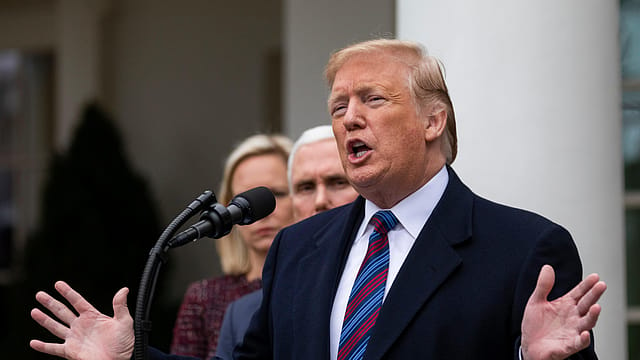Donald Trump’s return sparks global reactions: How day one is rewriting rules
ADVERTISEMENT

Donald Trump, who assumed office as the 47th President of the United States on January 20, announced at least 50 executive decisions on his first day in office, many of which have global ramifications. President Trump’s 'America First' agenda includes a series of measures related to border security and immigration, withdrawal from climate-friendly initiatives undertaken by the previous administration—dismissed by him as ‘climate extremism’—and attempts to overhaul the governance and bureaucratic systems of the country. Some of these measures specifically target neighbouring countries like Mexico and Canada, which share land borders with the US, while others focus on China, the United States’ biggest rival in international trade. Additionally, there are decisions that could have far-reaching effects on other countries, including India.
Withdrawing from WHO
Trump’s decision to withdraw from the World Health Organization (WHO) is one such move. His announcement to exit the Paris Climate Agreement and greenlight large-scale oil and natural gas drilling in US territories is another. Furthermore, the “America First Trade Policy” directs government officials to investigate the causes of the country’s persistent trade deficits and recommend remedial measures, such as higher tariffs, which could impact India and other nations.
Trump’s dissatisfaction with the WHO is well documented. During his first term (2017–2021), following the COVID-19 pandemic, he declared that the US would exit the WHO due to its handling of the crisis. His other grievances included allegations of the organisation being under the undue political influence of certain member states, despite the US being its largest financial contributor. Although this withdrawal was not completed due to the change in administration, Trump 2.0 is determined to finish what was started. On January 20, an executive order paused all future transfers of US government funds and resources to the WHO, recalled US personnel and contractors working with the organisation, and sought to identify alternative, credible partners to undertake the responsibilities previously handled by the WHO. Essentially, Trump aims to sideline the WHO and render it ineffective in global health matters that concern the US.
October 2025
As India’s growth story gains momentum and the number of billionaires rises, the country’s luxury market is seeing a boom like never before, with the taste for luxury moving beyond the metros. From high-end watches and jewellery to lavish residences and luxurious holidays, Indians are splurging like never before. Storied luxury brands are rushing in to satiate this demand, often roping in Indian celebs as ambassadors.
Impact on Other Countries
The US is the WHO’s top donor, contributing approximately $1.3 billion during the 2022–2023 biennium, compared to $856 million from Germany, the second-largest contributor. The US has also been a key partner in advancing global health security through the Global Health Security Agenda (GHSA), which promotes international health regulations. With the US withdrawing its support, the WHO will need to find alternative funding and expertise to sustain its operations. For India, which has benefited from WHO’s support in developing pandemic preparedness capabilities, a weakened WHO could mean an increased burden on the central government to allocate resources and develop independent public health solutions.
Withdrawing from the Paris Climate Pact
The Paris Agreement under the United Nations Framework Convention on Climate Change placed significant obligations on developed nations to reduce greenhouse gas emissions and contribute financial resources to combat global climate change. Trump’s withdrawal from the pact reflects his desire for the US to pursue economic development without environmental restrictions. While this decision was initially made during his first term, it was reversed under the Biden administration. By withdrawing from the agreement, Trump aims to renew US oil and gas exploration and increase its global presence as an energy producer.
Impact on India
The withdrawal could have mixed implications for India. On one hand, it may align with India’s long-standing position advocating the right to use conventional energy for economic development. On the other, it underscores the need for India to enhance its ‘Atmanirbhar Bharat’ initiatives to reduce dependence on imported raw materials for green energy transitions, such as processed critical minerals and solar panels.
Trade Policy
Trump’s “America First Trade Policy” continues his earlier efforts to protect domestic industries by imposing higher tariffs on imports. The policy includes investigations into the causes of the US’s trade deficits, an examination of the national security implications of such deficits, and recommendations for remedial measures such as global supplemental tariffs. It also calls for reviews of the United States-Mexico-Canada Agreement (USMCA) and other trade agreements to ensure reciprocal benefits for the US.
Impact on India
Ajay Srivastava, co-founder of the New Delhi-based Global Trade Research Initiative (GTRI), advises against overreacting to these measures, as many of them are routine practices already followed by the US government. For instance, establishing a new revenue collection system is redundant, as this function is already handled by customs authorities. Similarly, the review of free trade agreements (FTAs) and the examination of anti-dumping and countervailing duty regulations are standard regulatory practices.
Conclusion
Trump’s first-day directives also include changes to the Organisation for Economic Co-operation and Development (OECD)’s global tax deal, a re-evaluation of US foreign aid policies, and the rescission of several executive orders from the previous administration. His policies reflect an inward-looking, protectionist America. As these measures are implemented, their implications for various countries and sectors will become clearer. While some of Trump’s decisions may create challenges, they could also present new opportunities for India.
Fortune India is now on WhatsApp! Get the latest updates from the world of business and economy delivered straight to your phone. Subscribe now.
